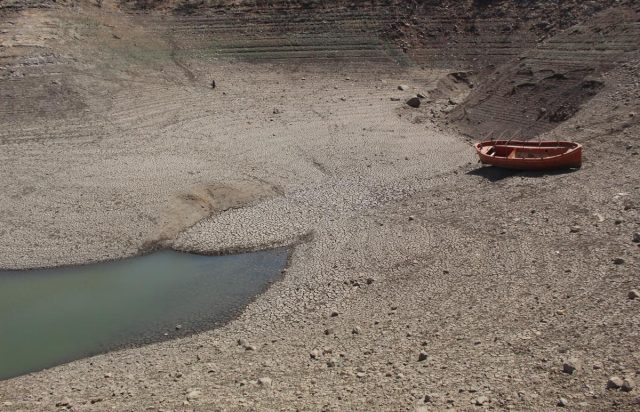Nandurbar feels diminished. Located at the edge of Maharashtra’s northern boundary in the Satpura hill range, it is enveloped by Madhya Pradesh in the north and Gujarat in the west. Just over the State border, the 182-metre Statue of Unity of Sardar Patel towers over the mostly tribal people of Nandurbar, a district in the development shadow. The undulating landscape, now green and wet, will turn back to brown and dry in a few months.
Often cut off from a number of daily-living services by the Narmada on its north and the Tapi on its south, reaching hamlets can take hours of navigating dirt tracks and streams. It is the norm for villagers to carry sick people in bamboo ambulances or ‘bamboolances’ to the closest primary health centre (PHC). A makeshift stretcher of bedsheets with two ends tied to bamboo sticks is a common sight. The 17-lakh population, as per the District Collector’s data, faces numerous healthcare challenges due to a scattered demographic and difficult geographical topography.
Policy-programme think tank NITI Aayog’s multidimensional poverty index score shows an improvement from 52.12% in 2015-16 to 33.17% in 2019-21. However, the district continues to remain the poorest in the State.
The riverbed floods during the monsoon but remains parched at other times of the year, effectively cutting the people of Nandurbar off from the rest of Maharashtra.
| Photo Credit:
Purnima Sah
Nirmala Kagadya Vasave, 38, a first-time Lok Sabha candidate from the People’s Party of India (Democratic) who lost the recently concluded general election, asks many rhetorical questions: “For over 75 years the tribal population of Nandurbar has been kept away from all kinds of growth, but if it had been a non-tribal district, would the situation have been the same? How is it possible that irrespective of the government we have remained stuck in time? If the [Prime Minister Narendra] Modi government can build tunnels in the Himalayas and bridges over sea routes, how difficult is it to construct a basic roadway and bridges to connect all the hamlets?”
Vasave, a social worker, has gone back to working with the community, educating tribal people like herself — predominantly Bhills and Pawaras — on their rights.
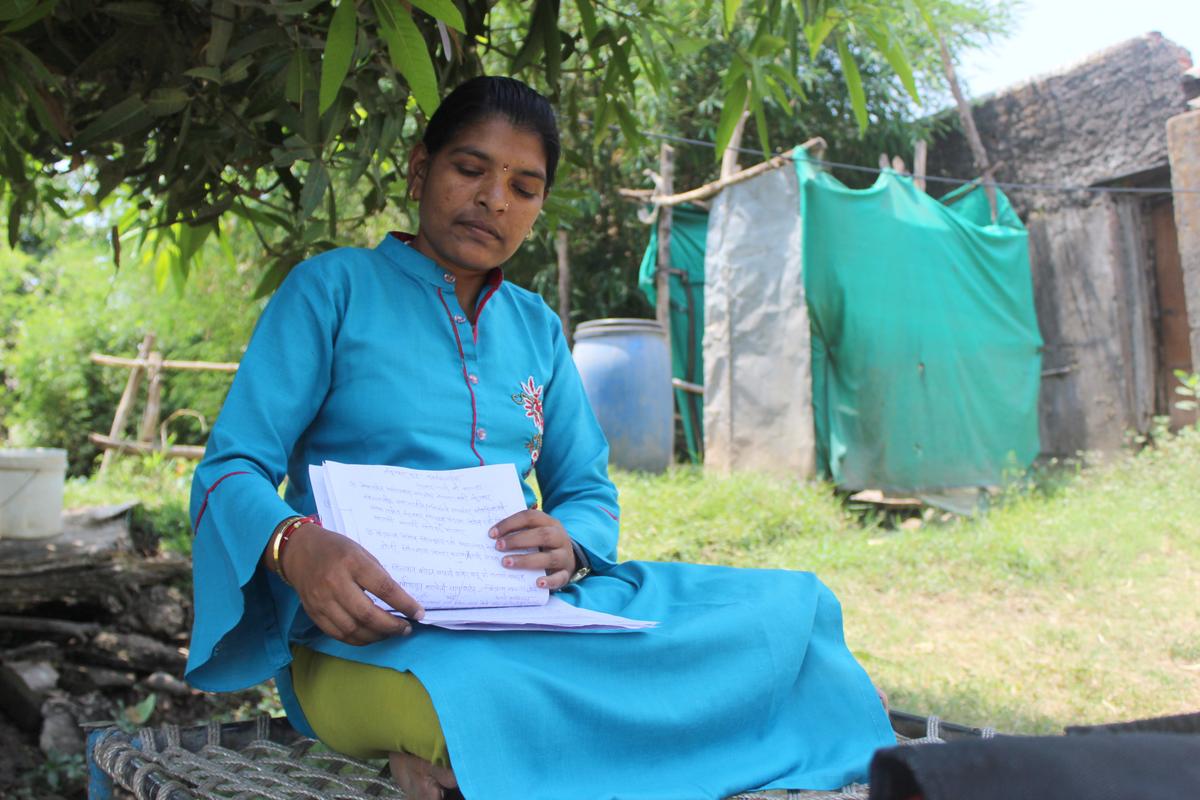
Nirmala Kagadya Vasave, 38, has resumed her work with the tribal community following her poll loss in the recently-concluded Lok Sabha elections.
| Photo Credit:
Purnima Sah
Despite the 2021-22 State health data revealing that Nandurbar’s sex ratio was 935 females to 1,000 males — higher than Maharashtra’s average of 920, the Infant Mortality Rate (IMR, up to 12 months) in the district was 20.1 per 1,000 live births, double the State’s IMR of 10.31. The same year, the neonatal mortality rate (NMR, 0-28 days) in Maharashtra was 7.8, whereas Nandurbar recorded 15.2 per 1,000, as per the Public Health Department of Nandurbar. The Child Mortality Rate (CMR) of children below five years was 2.21 in Maharashtra, whereas Nandurbar reported 4.1.
When the lack of a road is a health hazard
At 8 a.m. on a weekday, Sangita Keshav, who is 28 weeks pregnant, is visiting Bhilgaon PHC for the first time with her husband Keshav Jamsingh Pawara. They have arrived on his motorcycle bumping along untarred tracks. This is her sixth pregnancy. The 25-year-old mother from Sawaryadigar village in Akrani tehsil says that all her five children were born at home without any regular check-ups or medical intervention. “We have a male midwife in our village who has assisted many women in childbirth for free. We have immense trust in him. This time around I have pain in my waist and abdomen, so the ASHA (Accredited Social Health Activist) didi insisted that I consult the doctors at the PHC,” she says.
Pawara remembers trying to bring her in a ‘bamboolance’ during previous pregnancies, but says they walked back because he was nervous about the bumps on the road.
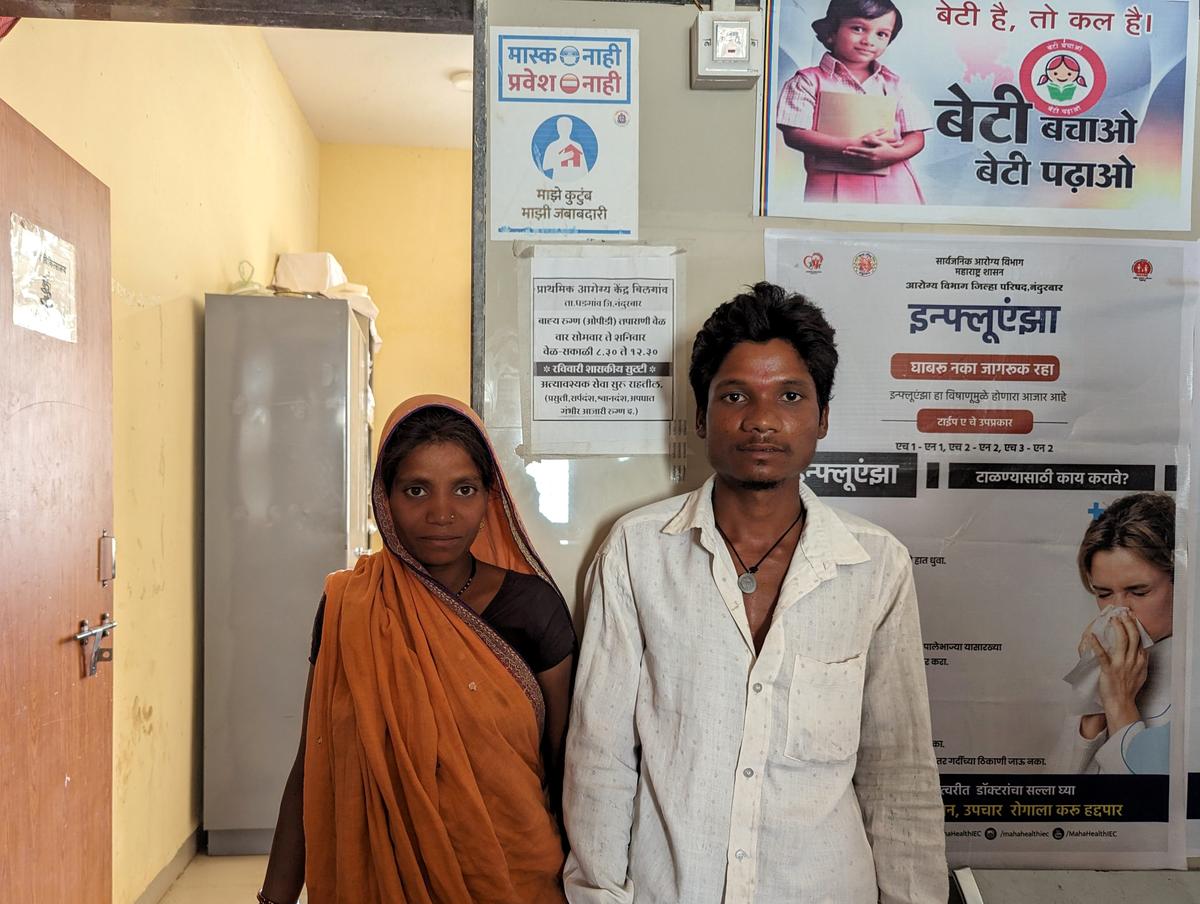
Sangita Keshav and her husband, Keshash Jamsingh Pawara, visiting the Bhilgaon PHC for the first time.
| Photo Credit:
Purnima Sah
From April 2023 to January 2024, the maternal mortality rate (MMR, [number of maternal deaths/number of live births]x1,00,000) stood at 103 in Nandurbar.
Dr. Kantilal Pawara, the taluka health officer at the Block Public Health Unit, Dhadgaon, says, “The 2023-24 data reveals the birth rate of Nandurbar is 16.8 but Dhadgaon’s birth rate alone is 26 per 1,000 people. There are many reasons: early marriage, early pregnancy, no awareness of contraceptives or their usage, and no understanding of family planning. Recently, we started family planning sessions to educate people as most couples here have more than six children.”
He had a new hospital building built last year, but Dhadgaon is often cut off from other areas during the monsoon, and boat ambulances have to be used. There are no real roads here either.
There are 322 approved health centres in the talukas of Dhadgaon, Shahada, Taloda, Nandurbar and Navapur, of which 293 are functional, and 273 of them are sub-centres with concrete infrastructure, while 29 are under construction. A total of 20 sub-centres do not have buildings available, and in the case of 2 sub-centres, the site to construct them is not available.
Long journey, but no guaranteed assistance
A Mahindra Bolero ambulance brings home 12 women passengers at various stages in their pregnancy after a day spent at the Civil Hospital in Shahada subdivision of Taloda tehsil. The women have travelled 160 to 250 km one way for a sonography, and are scattered across many villages. The women gather at their nearest PHC, from where they were picked up around 8 a.m.
ASHA worker Chandrakala Padavi, who assisted them, walks hamlet to hamlet to create awareness on the need for routine checkups and institutional births.
“Many women give birth without any medical aid. I have asked the health department to arrange for their meals and water when they wait for hours at the sonography centre. Since there is only one sonologist at the Civil Hospital that is government-run, there is no other option,” she says. In 2022-23 there were 31,566 institutional deliveries and 2,869 home deliveries in the district.
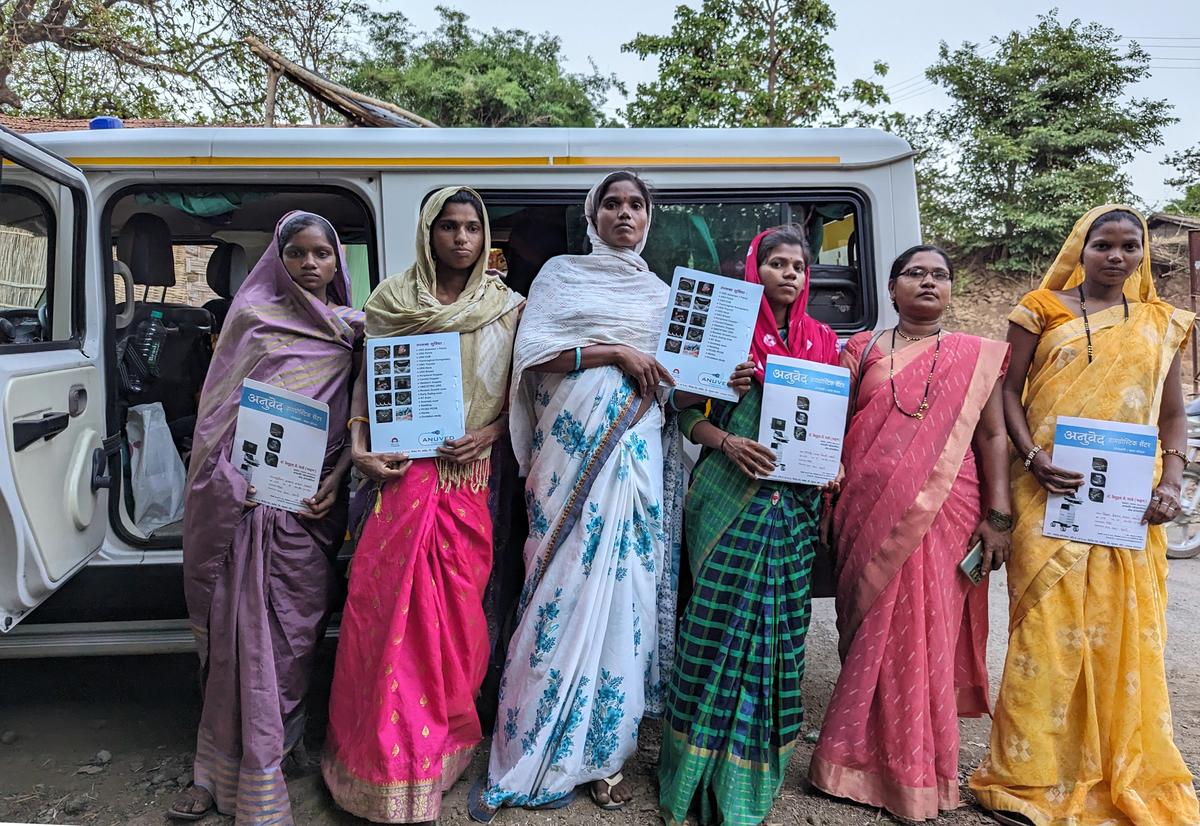
A makeshift ambulance brings home 12 women passengers at various stages in their pregnancy after a day at the civil hospital in Shahada subdivision of Taloda Tehsil in Maharashtra.
| Photo Credit:
Purnima Sah
“Deaths could be avoided if the region was accessible by road and had phone network connectivity,” says District Health officer Dr. Ravindra Sonawane, adding that ‘bamboolances’ are used to reach a point from where an ambulance could pick people up.
“In May, we started distributing mother-babycare kits to expecting mothers,” he says, adding that they have given out 6,500 kits so far. Each box contains a mosquito net, baby clothes, a nappy, baby cap, a towel each for the baby and mother, a dry sheet, woollen cap and socks, a rubber sheet, sanitary pads, sterile umbilical cord clamp, surgical blade, cotton, gauze dressing pad, plastic bag, and surgical gloves. “We hope this way the chances of contracting an infection during and after birth will be minimised,” he says.
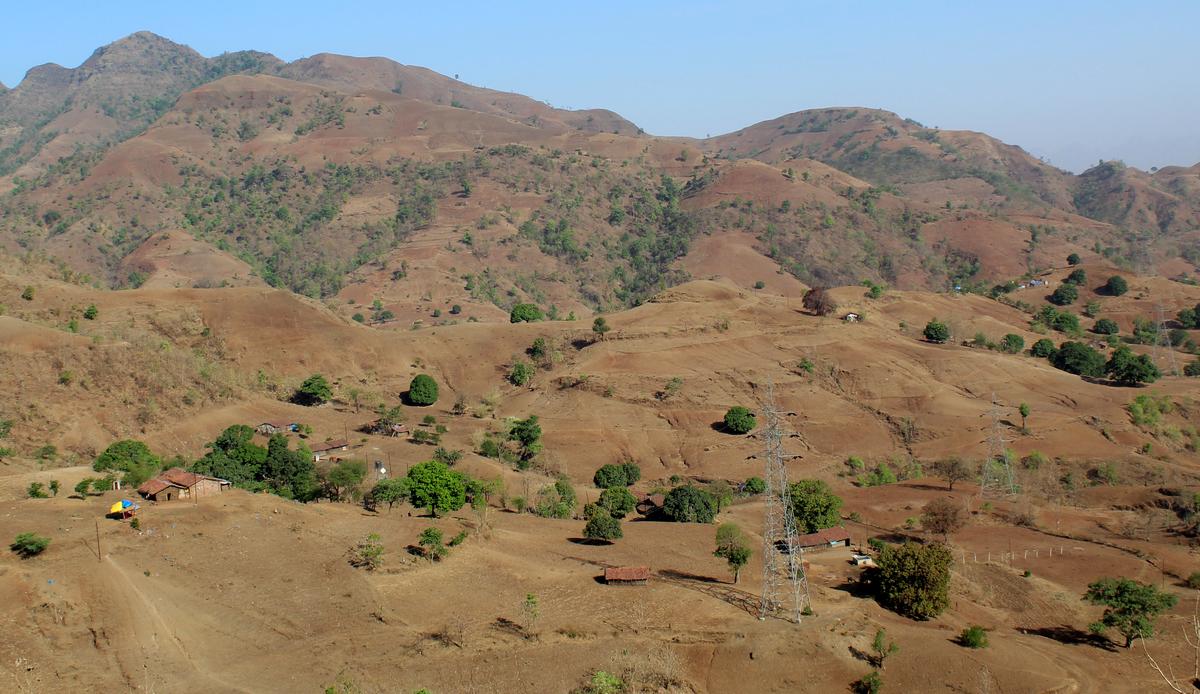
A hamlet in Nandurbar which recently received a mobile phone tower.
| Photo Credit:
Purnima Sah
In 2023, 75 child deaths were reported in the district. In a bid to grapple with the rising child and maternal mortality rates, Nandurbar District’s then Chief Medical Officer Sawan Kumar, who is now the Chief Executive Officer, Zilla Parishad, Nandurbar, had launched ‘Mission Lakshya 84 Days’ on September 1, 2023.
“This programme aims to increase the percentage of institutional delivery in the district. Antenatal mothers from 42 days before delivery to 42 days after delivery are followed by medical officers, community health officers, auxiliary nurse midwives, and ASHA workers through routine and additional visits to pregnant and lactating women for 100% institutional deliveries,” he says. They call this ‘Maherghar’ (maternal homecare) facility services. He claims that these steps have brought down the home delivery percentage from 8.2% in 2020-21 to the State average of 1.2%; IMR from 21 to 16; and CMR from 4.3 to 1.9 so far this year.
Money and power
Latika Rajput, a member of the Narmada Bachao Andolan and the State-appointed core committee says, “There are hardly any ambulances, and those that are there are old and ill-maintained. The district has 61 ambulances by 102 (ambulance helpline) and 14 ambulances by 108 (emergency helpline) on emergency response services. There are 25 permanent and 36 contractual drivers to operate these ambulances. There is no public transport, and privately-run boats and local vehicles are unreliable. Even at the PHC, there is no guarantee of finding a doctor.”
There are 116 permanent PHC doctors. Most of the time, the patients are referred to the rural hospital (RH) and from there to Civil Hospital. “The political will is zero here, so people are left to suffer,” she says.
Anil Bhaidas Patil says since he took charge as Nandurbar’s Guardian Minister in October last year, he has initiated many development projects and the work is in progress. “With the help of the District Administration and Armed Force Medical College, Pune, the first of its kind state-of-the-art fully-equipped Sickle Cell Testing Laboratory was inaugurated on December 6, 2023 at Civil Hospital in Nandurbar,” he says.
MLA and Bharatiya Janata Party leader from Nandurbar, Vijaykumar Krishnarao Gavit, who was the Minister of Tribal Development of Maharashtra from 2004-09, says it is very difficult to get medical staff to join medical units in remote areas like Nandurbar, as most professionals want to work in bigger cities. “In 2023, I introduced Bhagwan Birsa Munda Jodaraste Scheme, a State government scheme to link all tribal villages in Maharashtra with main roads. The project is estimated to cost ₹5,000 crore, and nearly 6,838 km of road will be constructed as part of the scheme. For Nandurbar alone we have sanctioned ₹3,000 crore to link roads and construct bridges,” he says, adding that the district will see change in the next two years.
Of 81 approved posts for medical officers (Group A), 27 are vacant, and of 85 Medical Officer (Group B) posts, 23 are vacant. Under the National Health Mission, 986 posts are approved, of which 172 are vacant. Of 160 approved posts for Medical Officer, 68 positions are still vacant. There are 192 community health officers, with 52 posts are still vacant.
Last year the district health department had put out an advertisement calling for specialists for the posts of radiologists, gynaecologists, paediatricians and others, with a salary of ₹1.5 lakh per month. There was not a single applicant.
The floating dispensaries of Nandurbar
Since 2016, Gulab Singh Nurjipadvi has been working in one of three boat ambulances run by the Maharashtra government as a driver. He ferries the one in Dhadgaon; there are two in Akkalkuwa taluka. As the boat sails through the Narmada backwaters, he points to the hills, “In front, you can see Madhya Pradesh. On our right is Maharashtra’s Junana village, and Gujarat is 20 km from here. Our boat checks 50 patients daily from Monday to Saturday.
Rakesh Chandrasingh Pawara, the health officer from Roshamal PHC, has been working in the boat dispensary for the last 15 years. The unit is a couple of kilometres away from the river in Akarani taluka, about 86 km from Nandurbar town, located in the middle of the Satpura ranges, where there is no concrete road, just pebbled terrain. “We can only do basic first aid and give medicines, but for treatment the patient must be taken to the nearest PHC. It is generally challenging to take pregnant women on the boat, then put them in a ‘bamboolance’ to take them to the ambulance point, and then transfer them to the nearest PHC,” he says, adding that during the monsoon, it becomes impossible. He feels it may be wise to start boat ambulances to deliver basic medical care until roads and bridges reach. “These can also have the facility for childbirth,” he adds.
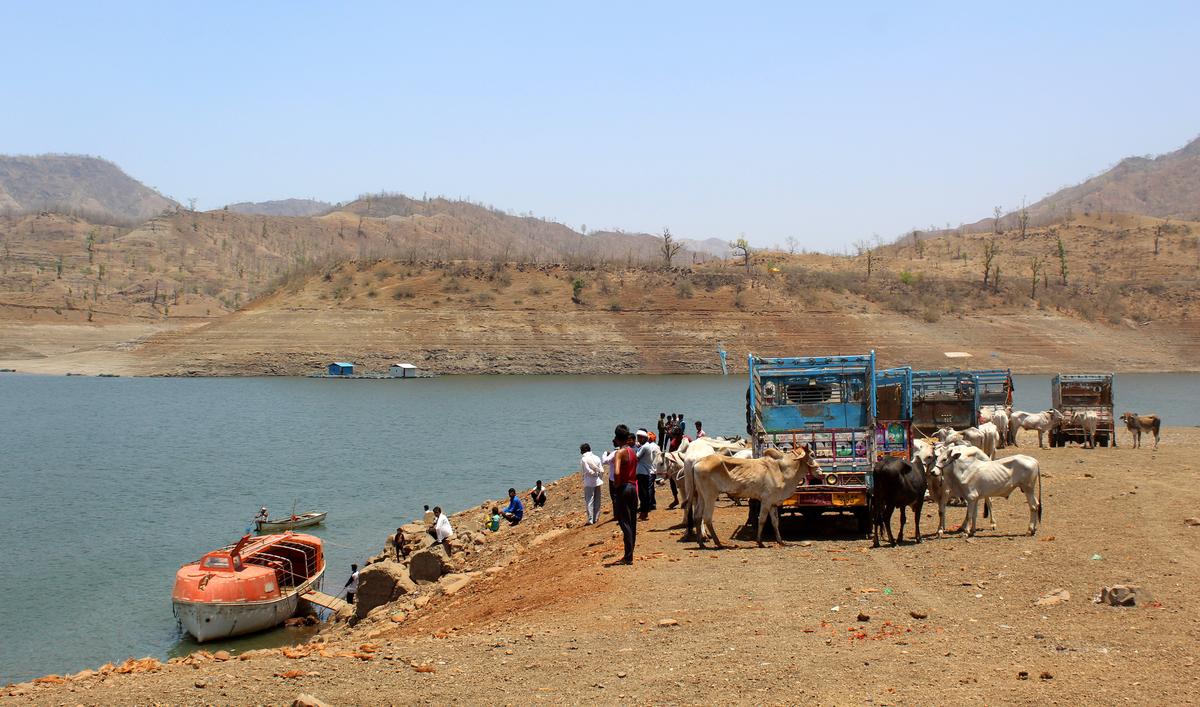
People wait at the Chichkhedi point for a boat to go to the other side of the Satpura mountain range.
| Photo Credit:
Purnima Sah
Dr. Chetan Rawate and ANM (Auxiliary Nursing Midwifery) staff Damayanti Valavi at one of the boat dispensaries at Bhusha Point in Dhadgaon say they cater to five villages, including those that fall under Madhya Pradesh.
“We urgently require a mobile hospital tent that comes with foldable furniture. This will help us set up small medical camps inside the villages, especially during the rains, when the reach is nil. Apart from maternal and childcare challenges, we have many snakebite cases that need urgent attention.”
Vikram Konya Padavi is not quite sure about his actual age but guesses he is in his 20s and his wife is two years younger than him. Two years ago, he built a hut using bamboo and plastic sheets just 2 km from the Narmada backwaters as it is convenient to catch fish.
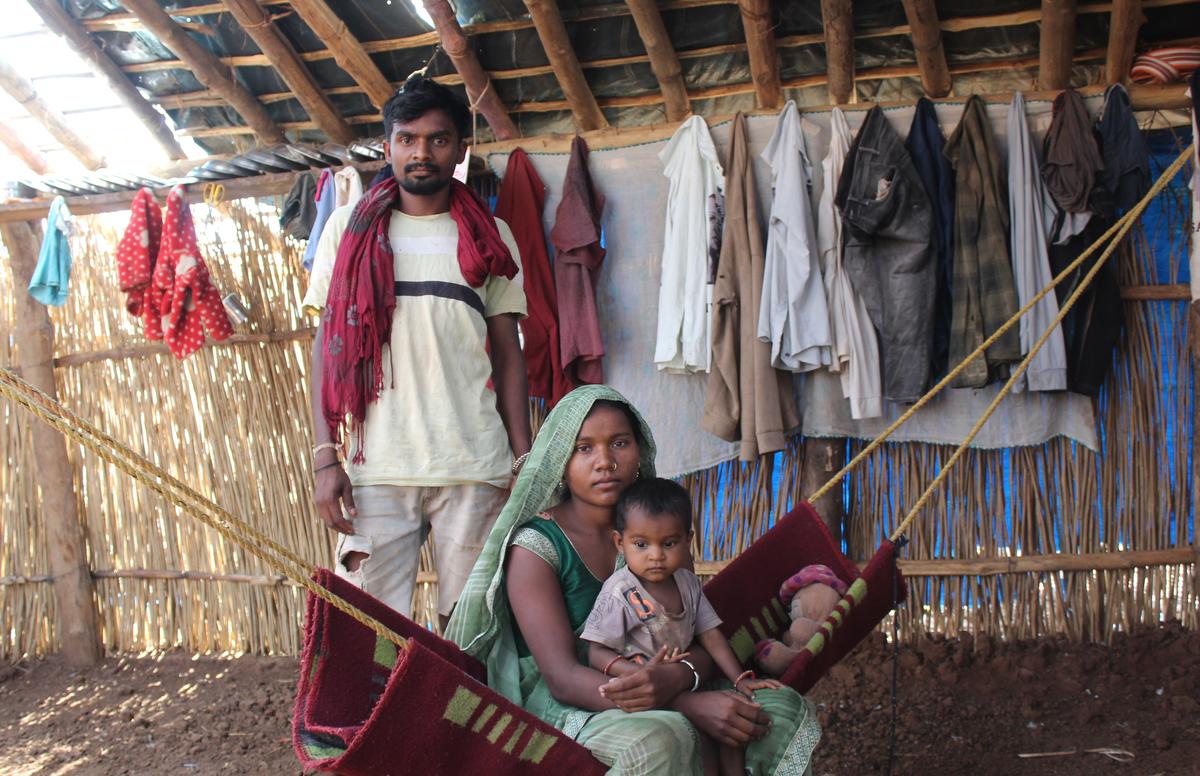
Vikram Konya Padavi stays near the banks of the Narmada so a boat ambulance can reach him quickly in the case of an emergency.
| Photo Credit:
Purnima Sah
“I sell the fish in Dhadgaon, 30 km away from here. The private sharing vehicle charges ₹50 one way and I earn around ₹150 to ₹200. Another reason for staying closer to the backwaters is to get the boat ambulance service quicker in case of an emergency, but we must wait for hours for them to show up in our area. We wave a cloth piece, and when they spot us, they come.”
Last year, his wife gave birth at home as the boat did not show up on time. The women in his family helped. “How long will we keep waiting?” he asks.


